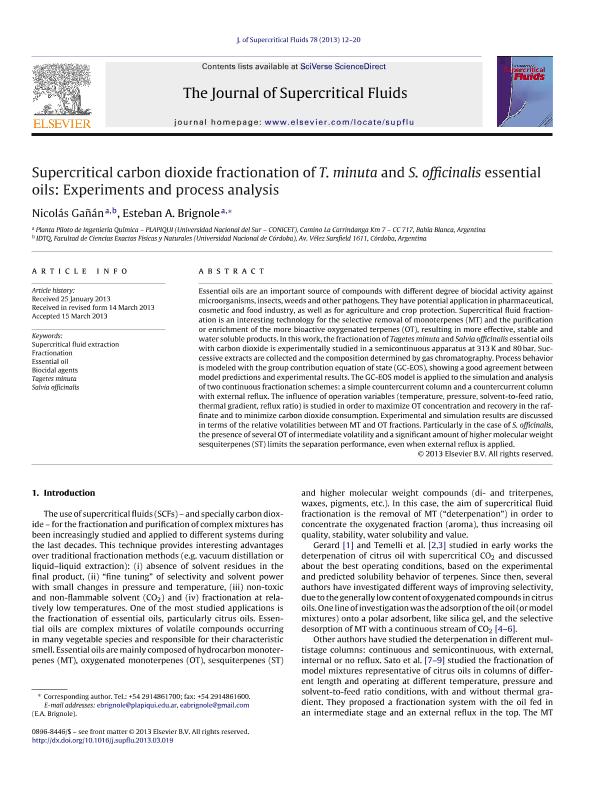Mostrar el registro sencillo del ítem
dc.contributor.author
Gañan, Nicolas Alberto

dc.contributor.author
Brignole, Esteban Alberto

dc.date.available
2017-01-24T20:57:47Z
dc.date.issued
2013-06
dc.identifier.citation
Gañan, Nicolas Alberto; Brignole, Esteban Alberto; Supercritical carbon dioxide fractionation of T. minuta and S. officinalis essential oils: Experiments and process analysis; Elsevier Science; Journal of Supercritical Fluids; 78; 6-2013; 12-20
dc.identifier.issn
0896-8446
dc.identifier.uri
http://hdl.handle.net/11336/11871
dc.description.abstract
Essential oils are an important source of compounds with different degree of biocidal activity against microorganisms, insects, weeds and other pathogens. They have potential application in pharmaceutical, cosmetic and food industry, as well as for agriculture and crop protection. Supercritical fluid fractionation is an interesting technology for the selective removal of monoterpenes (MT) and the purification or enrichment of the more bioactive oxygenated terpenes (OT), resulting in more effective, stable and water soluble products. In this work, the fractionation of Tagetes minuta and Salvia officinalis essential oils with carbon dioxide is experimentally studied in a semicontinuous apparatus at 313 K and 80 bar. Successive extracts are collected and the composition determined by gas chromatography. Process behavior is modeled with the group contribution equation of state (GC-EOS), showing a good agreement between model predictions and experimental results. The GC-EOS model is applied to the simulation and analysis of two continuous fractionation schemes: a simple countercurrent column and a countercurrent column with external reflux. The influence of operation variables (temperature, pressure, solvent-to-feed ratio, thermal gradient, reflux ratio) is studied in order to maximize OT concentration and recovery in the raffinate and to minimize carbon dioxide consumption. Experimental and simulation results are discussed in terms of the relative volatilities between MT and OT fractions. Particularly in the case of S. officinalis, the presence of several OT of intermediate volatility and a significant amount of higher molecular weight sesquiterpenes (ST) limits the separation performance, even when external reflux is applied.
dc.format
application/pdf
dc.language.iso
eng
dc.publisher
Elsevier Science

dc.rights
info:eu-repo/semantics/openAccess
dc.rights.uri
https://creativecommons.org/licenses/by-nc-sa/2.5/ar/
dc.subject
Supercritical Fluid Extraction
dc.subject
Fractionation
dc.subject
Essential Oil
dc.subject
Biocidal Agent
dc.subject
Tagetes Minuta
dc.subject
Salvia Officinalis
dc.subject.classification
Ingeniería de Procesos Químicos

dc.subject.classification
Ingeniería Química

dc.subject.classification
INGENIERÍAS Y TECNOLOGÍAS

dc.title
Supercritical carbon dioxide fractionation of T. minuta and S. officinalis essential oils: Experiments and process analysis
dc.type
info:eu-repo/semantics/article
dc.type
info:ar-repo/semantics/artículo
dc.type
info:eu-repo/semantics/publishedVersion
dc.date.updated
2017-01-24T18:30:23Z
dc.journal.volume
78
dc.journal.pagination
12-20
dc.journal.pais
Países Bajos

dc.journal.ciudad
Ámsterdam
dc.description.fil
Fil: Gañan, Nicolas Alberto. Consejo Nacional de Investigaciones Científicas y Técnicas. Centro Científico Tecnológico Bahía Blanca. Planta Piloto de Ingeniería Química (i); Argentina. Universidad Nacional de Córdoba. Facultad de Ciencias Exactas, Físicas y Naturales; Argentina
dc.description.fil
Fil: Brignole, Esteban Alberto. Consejo Nacional de Investigaciones Científicas y Técnicas. Centro Científico Tecnológico Bahía Blanca. Planta Piloto de Ingeniería Química (i); Argentina
dc.journal.title
Journal of Supercritical Fluids

dc.relation.alternativeid
info:eu-repo/semantics/altIdentifier/url/http://www.sciencedirect.com/science/article/pii/S0896844613001174
dc.relation.alternativeid
info:eu-repo/semantics/altIdentifier/url/http://dx.doi.org/10.1016/j.supflu.2013.03.019
Archivos asociados
